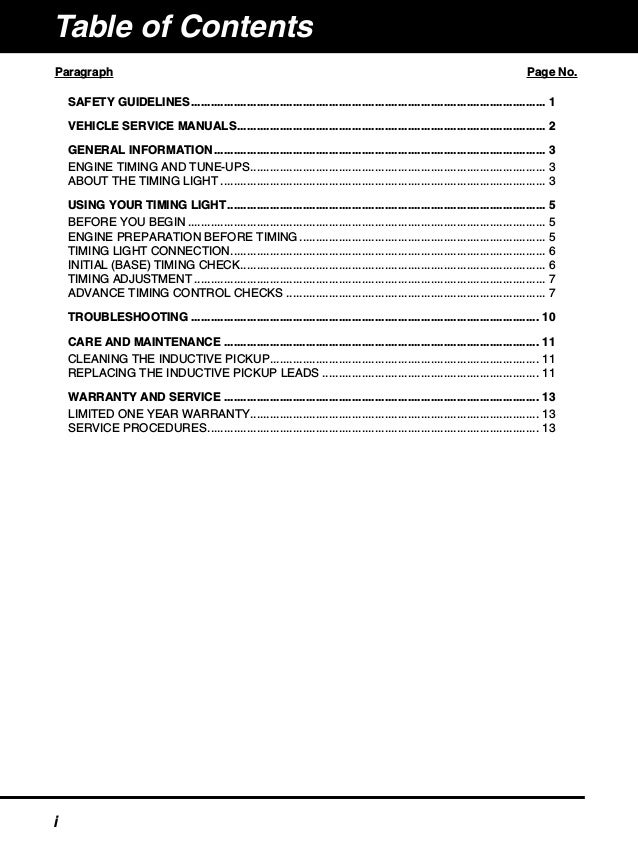This timing light is designed for use on most late model import or domestic vehicles equipped with conventional or electronic ignition systems, or with DIS (distributorless ignition systems). TIMING LIGHT CONNECTION WARNING: Always keep hands, timing light, lead wires and clips away from moving engine parts and hot surfaces. Auto Timing Light Reviews Click Here A timing light is an essential tool for service engineers and mechanics for fault d.
- Innova 3568 Timing Light Problems
- Equus Timing Light
- Innova Timing Light 3568 Manual Pdf
- Innova Timing Light 3568 Manual Pdf
- Innova Timing Light 5568

Checking Mechanical/Centrifugal Timing
Advance
1.
MAKE SURE the timing light Advance
Display shows 0 (zero) degrees. Press the
Zeroing Switch if necessary to obtain 0
degree indication.
2.
While performing an INITIAL (BASE)
TIMING CHECK as previously described,
slowly increase engine speed to the
manufacturer's specified rpm for mechani-
cal/centrifugal advance, and observe the
rotating timing mark for change. The timing
mark should appear to move smoothly, in
the opposite direction of engine rotation,
away from the reference pointer.
3.
Press the Advance Increment and Ad-
vance Decrement switches, as necessary,
until the rotating timing mark and the
reference pointer realign at the initial
(base) timing mark as previously re-
corded. Read the degrees of mechanical
or centrifugal advance on the LCD display.
See Figure 5.
4.
Note the degrees advance shown on the
LCD display, and compare this value with
the manufacturer's specification for
mechanical or centrifugal timing advance
for the rpm specified.
■
If the position of the rotating timing
mark does not change during the
mechanical/centrifugal advance
check, the mechanical weights asso-
ciated with your vehicle's mechanical
advance mechanism (if equipped)
may be rusted or binding.
5.
Repeat the test, as needed, for all engine
speeds specified by the manufacturer's
instructions.
Checking Vacuum Timing Advance
1.
With the engine off, disconnect the vacuum
hose from the distributor's vacuum advance
port. Plug the vacuum hose securely.
2.
Connect the vacuum pump to the
distributor's vacuum port. Do not apply
vacuum at this time.
3.
Start the engine and perform INITIAL
(BASE) TIMING CHECK as previously
described. Record the degree(s) of initial
(base) timing.
4.
Using the vacuum pump, apply the
manufacturer's specified amount of
vacuum to the distributor's vacuum port.
5.
Aim the timing light at the timing marks
and press the Advance Increment and
Advance Decrement switches, as
necessary, until the timing marks are
realigned to the initial (base) timing mark
as recorded in step 3.
6.
The difference between the reading
obtained in step 3 {initial (base) timing}
and the value obtained in step 5 is the
vehicle's vacuum advance. Compare this
value with the manufacturer's specifica-
tions for vacuum advance.
7.
Repeat the test, as needed, for each
amount of vacuum specified by the
manufacturer's instructions.
8.
Turn off the ignition and disconnect the
timing light and vacuum pump from the
engine. Unplug and reconnect the vacuum
hose to the distributor's vacuum port.
Innova 3568 Timing Light Problems
7
ADVANCE
DISPLAY
ADVANCE
INCREMENT
BUTTON
ADVANCE
DECREMENT
BUTTON
Fig. 5. Advance Control Knob Operation
NOTE
If timing mark movement is rough or erratic,
the mechanical advance system may be de-
fective. Service and repair the mechanical
advance system in accordance with the man-
ufacturer's instructions before continuing.
NOTE
A vacuum pump equipped with a vacuum
gauge is needed to check vacuum advance.
Equus Timing Light
This timing light includes a full range of options designed to meet the demands of DIYers with many of the features that professional installers demand. This digital timing light is for most 12-volt gasoline engines and works on conventional, electronic, and computer controlled ignition systems. It also works on both domestic and import vechicles. It has a split-screen digital LCD readout which displays tachometer and advance functions simultaneously from 249-9,990 RPM and digital advance from 0-90 degrees. This timing light provides a simple and efficient means of checking your vehicle's ignition timing and provides the additional ability to check the operation of your vehicle's mechanical or vacuum advance timing controls. It includes a rotating barrel for better aim at the timing mark, detachable leads, metal inductive pickup, and protective hand guard. It also has a patented skip circuitry test up to 9,990 RPM.
Innova Timing Light 3568 Manual Pdf
Features:
- Top-of-the line timing light for the selective do-it-yourselfer
- Split-screen digital LCD readout displays Tachometer and Advance functions simultaneously
- Digital Tach: 249 to 9,990 RPM
- Digital Advance: 0° to 90°
- Slim, rotating barrel for better aim at timing mark
- Detachable leads, metal inductive pickup
- Protective Hand Guard
- Patented Skip Circuitry Test up to 9,990 RPM
- One-hand Operation
Innova Timing Light 3568 Manual Pdf
A GOOGLE AD IS SHOWN BELOW-IT IS NOT ASSOCIATED WITH THE PRODUCT ABOVE